Dopamine, a crucial chemical messenger in the human brain, does not function as previously believed. Traditionally regarded as a slow-moving signal that diffuses throughout the brain, new research indicates that dopamine also operates through rapid, targeted bursts. This revelation, emerging from studies at the University of Colorado and Augusta University, suggests that localized dopamine signaling could be a fundamental aspect of its role in neural communication.
The research highlights a significant distinction between dopamine’s functions in the brain and in the rest of the body. In the bloodstream, it modulates organ functions and immune responses, while in the brain, dopamine influences diverse behaviors including movement, mood, sleep, memory, reward, and motivation. Neurons that release dopamine display various firing patterns, yet the specific meanings behind these patterns have remained unclear.
Scientists employed advanced imaging techniques to investigate this phenomenon in live mice. They triggered localized dopamine release and observed its effects using fluorescent staining. This allowed researchers to see how the activation occurred in small regions of nearby neurons, resulting in a quick neural response. In contrast, broader dopamine release resulted in a slower, more widespread response.
“Our current research found that dopamine signaling and transmission in the brain is much more complex than we thought,” said Christopher Ford, a pharmacologist at the University of Colorado. He emphasized that this study lays the groundwork for understanding how different behaviors could be regulated by dopamine.
The neurons examined in this research are primarily located in the brain’s striatum, an area involved in both motor and reward systems. This region is rich in dopamine-releasing neurons and receives inputs from various parts of the brain. It has been implicated in several neurodegenerative disorders, including Parkinson’s disease, schizophrenia, and ADHD. For example, Parkinson’s disease is characterized by the degeneration of dopamine neurons that connect to the striatum.
Understanding how dopamine transmits signals in the striatum may lead to new treatment options for these conditions. Ford noted, “We are really only at the tip of the iceberg in trying to understand how dysfunctions in dopamine contribute to diseases like Parkinson’s disease, schizophrenia, or addiction.” He emphasized the need for further research to explore how specific changes in dopamine signaling relate to various neurological and psychiatric diseases.
This comprehensive study was published in the journal Science, contributing to the evolving discourse on dopamine’s multifaceted role in the brain. As research continues, the insights gained may pave the way for innovative approaches to treatment and a deeper understanding of brain function.


































































